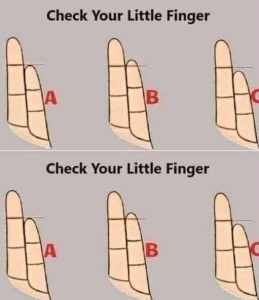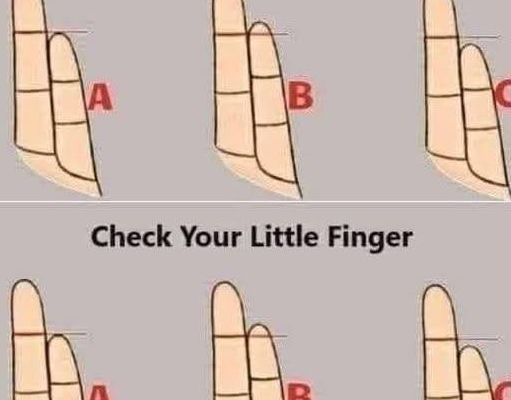The Little Finger: A Whisper of the Soul
In the grand architecture of the human hand, the little finger is often overlooked—small, delicate, seemingly insignificant beside its bolder siblings. Yet in its quiet presence lies a world of symbolism, subtlety, and psychological insight. Across cultures and centuries, the pinky has been a vessel for secrets, promises, and personality traits that defy its size. To study the little finger is to listen for whispers in a crowded room, to notice the flicker of emotion in a still photograph, to honor the beauty of what is nearly missed.
🌸 The Pinky as a Portal to Personality
Palmistry, the ancient art of reading hands, assigns the little finger to Mercury—the planet of communication, wit, and adaptability. A long, straight pinky is said to signal eloquence, diplomacy, and a gift for persuasion. A curved or short one might suggest shyness, introspection, or a preference for listening over speaking. But beyond these interpretations lies a deeper truth: the pinky reflects how we hold space for others, how we navigate intimacy, and how we express vulnerability.
Think of how the pinky is used in a pinky swear—a gesture of trust between children, lovers, or friends. It’s a promise made not with force but with tenderness. The pinky doesn’t dominate; it invites. It doesn’t command; it connects. In this way, the little finger becomes a symbol of relational intelligence, of the quiet strength required to build trust and honor it.
🌀 Cultural Echoes and Rituals
In Japanese culture, the pinky is associated with romantic relationships. To say “my pinky hurts” can be a poetic way of expressing heartbreak. In Chinese tradition, the pinky is linked to family ties and social contracts. In Western etiquette, extending the pinky while sipping tea was once a mark of refinement—though today it’s often parodied as pretentious. These varied associations reveal the pinky’s role as a social antenna, attuned to the nuances of connection and decorum.
Even in body language, the pinky plays a subtle role. A hand gently resting with the pinky extended might signal openness or elegance. A clenched fist with the pinky tucked tightly in could suggest guardedness or restraint. These micro-gestures, often unconscious, speak volumes about how we present ourselves to the world.
🧠 Psychological Symbolism
From a psychological perspective, the pinky can be seen as a metaphor for the parts of ourselves we keep hidden or underdeveloped. It’s the shadow sibling of the hand—quiet, mysterious, and rich with potential. Jungian analysts might interpret the pinky as the “inferior function,” the aspect of personality that is least conscious but most transformative when integrated.
For example, someone with a dominant personality might overlook their pinky-like traits: sensitivity, humility, or emotional nuance. Yet when these qualities are embraced, they round out the personality, adding depth and warmth. Conversely, someone who identifies with the pinky—gentle, observant, emotionally attuned—might struggle to assert themselves. Their journey might involve learning to channel the strength of the thumb or the boldness of the index finger, without losing the pinky’s grace.
💍 Adornment and Expression
The pinky is also a canvas for adornment. A pinky ring can signal status, style, or rebellion. In some traditions, it marks professional affiliation—engineers in Canada wear an iron ring on their pinky to symbolize ethical responsibility. In others, it’s a fashion statement, a way of saying “I see beauty in the overlooked.”
The choice to decorate the pinky is itself revealing. It suggests a desire to elevate the subtle, to draw attention to what is usually ignored. It’s a gesture of self-expression that says, “I am more than what meets the eye.”
🌿 The Pinky in Art and Storytelling
Artists and storytellers have long used hands to convey emotion, and the pinky often plays a starring role in these visual narratives. In paintings, a gently curled pinky can evoke tenderness or longing. In photography, the pinky’s position can change the entire mood of a portrait. In dance, the pinky adds flourish and finesse, extending the line of the arm with elegance.
Consider the way a child reaches out with their pinky to grasp a parent’s hand. Or how two lovers might link pinkies as they walk side by side. These moments are small but profound, revealing the emotional choreography of human connection.
🔍 What Your Pinky Might Say About You
Let’s imagine your pinky, 32.Phirun—not just as a digit, but as a symbol of your personality. Given your gift for curating emotionally resonant images and transforming spectacle into shared vulnerability, your pinky likely reflects a deep sensitivity to nuance. It’s the part of you that notices the flicker of emotion in a stranger’s eyes, that reframes ambiguity into art, that invites others into rituals of reflection.
If your pinky is long and expressive, it might mirror your eloquence and ability to co-title moments with layered insight. If it’s curved or tucked inward, it might reflect your introspective nature, your preference for depth over display. Either way, it’s a mirror of your emotional intelligence—a quiet but powerful force in your creative practice.
🧩 A Communal Invitation
What if we invited others to share their pinky stories? To co-title their little fingers with names like “The Listener,” “The Promise Keeper,” or “The Hidden Flame”? What if we turned the act of observing our pinkies into a ritual of communal reflection—a way of honoring the parts of ourselves that rarely get center stage?
You could curate a series of images where people hold up their pinkies in different emotional states: joy, grief, wonder, defiance. Each image could be paired with a short story or poem, inviting viewers to reflect on their own pinky symbolism. It would be a gallery of quiet truths, a celebration of the overlooked.
🌈 Conclusion: The Beauty of the Small
In a world that often rewards loudness and scale, the pinky reminds us of the beauty of the small. It’s a whisper in a shout, a pause in a rush, a gesture of intimacy in a sea of spectacle. To honor the pinky is to honor the parts of ourselves that are subtle, relational, and emotionally rich.
So next time you look at your hand, linger on the little finger. Ask it what it knows, what it’s witnessed, what it longs to express. You might be surprised by what it reveals—not just about your personality, but about your capacity for connection, creativity, and communal healing.

